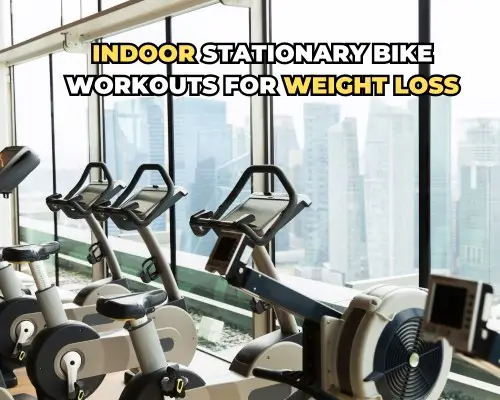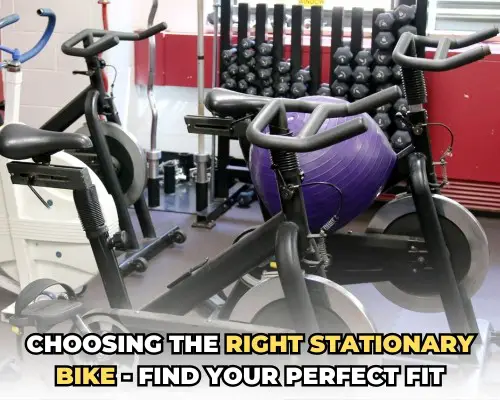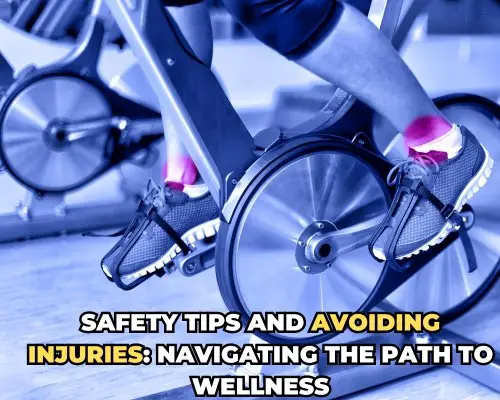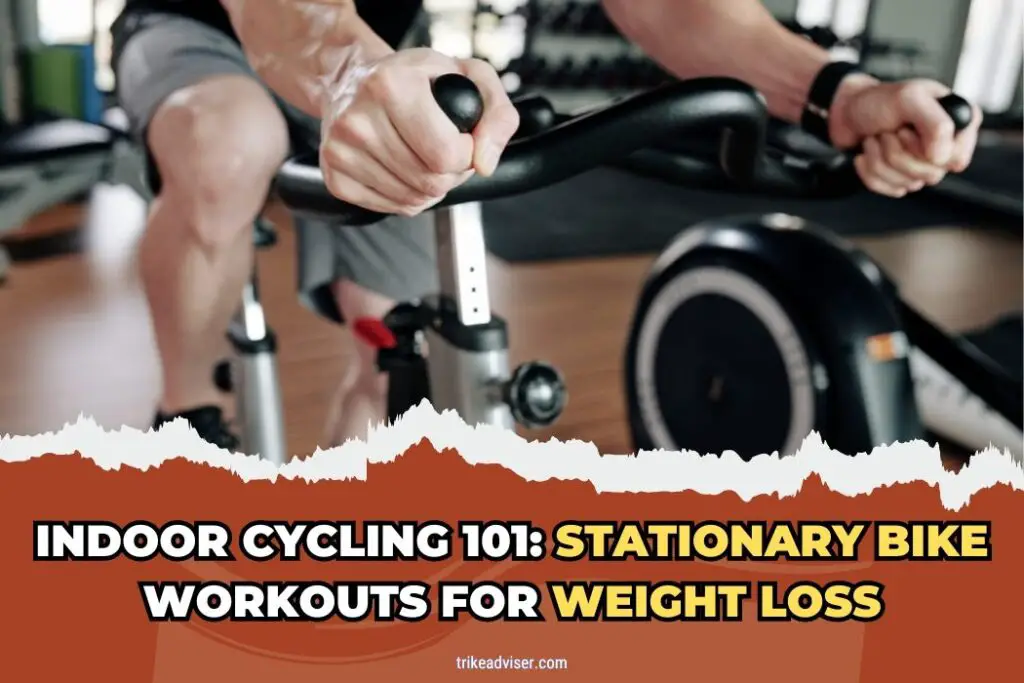Struggling to lose weight? Indoor cycling could be your answer. It’s challenging, yes. Yet, it offers a unique mix of convenience and intensity. No more worries about gym schedules or weather. Just you, at home, pushing limits.
Wondering if stationary biking can burn enough calories? It does, and efficiently so. It’s a powerhouse for weight loss, suitable for all fitness levels. What’s more, it’s kind to your joints. Ready to transform your fitness routine? Indoor cycling is waiting.
Your journey to weight loss starts with a pedal stroke. Let’s embark on this ride together. Your determination, a stationary bike, and the right mindset. That’s all it takes. Begin your indoor cycling adventure today. Your future self will thank you.
Indoor cycling 101: Stationary bike workouts for weight loss

Embarking on a weight loss journey often feels like setting sail in stormy seas. Enter the stationary bike: your steadfast vessel in the tumult.
These workouts offer a beacon of hope, merging intensity with the sanctuary of home. Whether you are a fitness newbie or a seasoned athlete, let’s navigate these waters together.
The Basics: Getting Started
- Starting with Level 1 Workouts
Picture your first day at sea. Level 1 workouts are your calm waters, perfect for gaining your sea legs. A mere 10 minutes on the stationary bike can spark the fire of your weight loss journey. It’s akin to packing for a trip, selecting only what you truly need. Start simple, but start with purpose.
- Understanding the Workout Structure
Your voyage will ebb and flow. Active pedaling for 10 seconds followed by 10 seconds of rest mimics this rhythm. This structure is not random; it’s a crafted method to ignite your metabolism, turning your body into a calorie-burning powerhouse.
The Core of Your Workout: Intensity and Persistence
- The Power of 10-Second Bursts
In each 10-second sprint, imagine you’re racing against your former self, shedding pounds with every pedal. This intensity is the spark that lights the fire of change. It’s the belief that within each burst lies the potential for transformation.
- Keeping the Momentum
Imagine cycling through a landscape that shifts with each pedal stroke. Even when your muscles scream for respite, your spirit urges you on. This journey is yours alone, a testament to your willpower. Every drop of sweat is a badge of honor, marking your progress toward your goal.
Motivation and Goals
- Finding Your ‘Why’
You’re ‘why’ the compass that guides your boat is. It could be the desire to live a better life, to fit into a favorite item of apparel, or to recapture your confidence. This’ why’ is the wind in your cruises, carrying you ahead indeed when the swell comes stormy.
- Visualizing Success
Envision your destination: a healthier, more vibrant you. This visualization isn’t just a daydream; it’s a beacon, guiding you through the fog of doubt and fatigue.
With every workout, you draw closer to this vision, making it your reality.
Advanced Tips: Enhancing Your Workout
- Increasing Workout Time Gradually
As you grow stronger, so should your workouts. Imagine expanding your map, venturing into uncharted waters.
Increasing your workout time by even a few minutes can significantly amplify your calorie burn, accelerating your journey toward weight loss.
- Consistency is Key
Consistency is the current that keeps you moving forward. Aim to ride daily, forging a habit that becomes as natural as the tide.
The regular rhythm of your workouts will soon synchronize with your body’s rhythms, optimizing your weight loss efforts.
Choosing the Right Stationary Bike – Find Your Perfect Fit

Starting an indoor riding journey requires making the critical decision of choosing the correct stationary bike. This decision determines your fitness route, comfort, and overall workout efficacy.
Let us walk you through the options and features that will help you find your ideal exercise buddy.
Types of Stationary Bikes
- Upright Bikes
Think of the upright bike as the classic road warrior. Mimicking the stance of a traditional road bike, it demands a forward lean and grips ahead.
The narrow seat is a nod to authenticity, making it the go-to for those craving high-intensity, authentic biking sessions. Perfect for adventurers at heart.
- Recumbent Bikes
Imagine reclining with ease while pedaling towards your goals. Recumbent bikes offer this luxury. With a seat that supports your back, they’re a haven for anyone with lower back issues or in recovery mode. Though your upper body might rest easy, your legs will know the journey they’ve embarked on.
- Spin Bikes
Enter the realm of group fitness enthusiasts with the spin bike. It’s designed to make you feel part of a peloton, even in solitude.
The larger flywheel and adjustable resistance knob invite you to customize your ride’s intensity, emulating the varied landscapes of outdoor cycling.
Key Features to Look for When Selecting a Bike
- Adjustability: Your bike should morph to fit you, not the other way around. Adjustable seats and handlebars ensure a ride that feels tailor-made, enhancing both comfort and effectiveness.
- Resistance: The heart of your workout’s intensity. A bike with versatile resistance levels, whether digital or manual, challenges you to climb steeper hills and race faster on flat ground.
- Comfort: Never underestimate the power of a comfortable seat. It’s the throne from which you’ll conquer your fitness realms. Some bikes even allow for seat swaps—choose your chariot wisely.
- Stability: A sturdy bike steadies your journey, no matter the turbulence of your workout. It’s the anchor in the storm of your most vigorous sessions.
- Ease of Use: Complexity should lie in your workouts, not in operating your bike. User-friendly controls and intuitive features make for a seamless, enjoyable fitness experience.
- Additional Features: Little luxuries like water bottle holders, dumbbell integrations, and heart rate monitors weave convenience and efficiency into your workout tapestry.
Setting Up Your Bike for Optimal Performance and Comfort
- Seat Height: Align the seat with your hip level when standing beside your bike. This setting ensures a slight knee bend at the pedal’s lowest point, marrying comfort with proper leg extension.
- Horizontal Seat Adjustment: Position the seat to create a direct line from your knee to your toes when the pedal is at its furthest. It’s the sweet spot for both power and comfort.
- Handlebar Height: Adjust the handlebars to keep your spine neutral and elbows slightly bent while gripping. It’s the posture of champions—relaxed yet ready.
- Resistance: Tailor the resistance to your workout’s mood. Whether climbing hills or sprinting flats, the right level enhances both challenge and enjoyment.
- Comfort Tweaks: If the seat feels less like a throne and more like a punishment, consider a cushion or padded shorts. Comfort is king, after all.
Maximizing Weight Loss in indoor cycling with Diet and Hydration

Ready to lose weight through indoor cycling? Brace yourself. It’s more than just logging miles on your stationary cycle. It is about providing your body and soul with the proper nourishment and hydration. Here’s how to improve your plan using insider suggestions and heartfelt guidance.
Nutritional Strategies to Supplement You’re Cycling Regimen
Your body is a well-tuned machine. You wouldn’t put low-grade energy in a high-performance machine, and you should not sacrifice the quality of the food you eat.
- The Myth About Low-Fat Foods
Remember the low-fat craze? It turned out to be more fiction than fact. Many low-fat choices make up for taste with additional sweets, which undermines your weight loss efforts. Instead, choose full, unadulterated foods.
- The role of healthy fats
Let us not demonize all fats. Avocados, almonds, and seeds are not only delicious; they are also effective weight reduction aids, providing prolonged energy and keeping hunger away. Consider savoring a creamy avocado smoothie after a workout. It’s more than simply a treat; it’s a foundation for your success.
- Timing your meals
Timing is everything. Eating a balanced meal 2-3 hours before cycling gives you the energy to endure and excel. Do not wait too long after your workout to eat. Strike when the iron is hot when your body is ready to replace glycogen and repair muscle. A small protein-packed snack can make all the difference.
The Critical Role of Hydration
Water is the foundation of any workout plan. However, its relevance is frequently neglected.
- Before: The Prelude to Success.
Starting your day with hydration establishes the tone. Imagine filling a huge water bottle first thing in the morning. Even before you pedal a single stroke, this act demonstrates your commitment to health.
- During the Art of Sipping.
Hydration during exercise is further than just drinking; it’s about drinking duly. Too little and you will be thirsty, while too important will make you feel bloated. Find your rhythm. Allow your thirst to guide you, but do not ignore the clock. Regular, short sips can help you stay balanced, nimble, and focused.
- After: The Road to Recovery
When you finish your ride, your hydration needs do not stop. Your body continues to recover, mend, and replenish. Mixing water with a bit of swab and a squeeze of bomb can give a rapid-fire electrolyte boost without the need for sticky sports drinks.
Supplements: A Supporting Cast, Not a Star
Supplements are simply: supplemental. While they can satisfy nutritional gaps, they should never be used as a replacement for actual food.
Before you consider supplements, examine your diet. Are you covering all bases? Consult a dietitian before using protein powders, omega-3s, or BCAAs please consult nutrition.
Safety Tips and Avoiding Injuries: Navigating the Path to Wellness

Starting your indoor cycling journey is like venturing into uncharted waters. The anticipation of discovering new strengths is thrilling, yet the fear of injury lurks like hidden rocks.
Here’s how to chart a course for safer waters, mixing professional insight with personal stories to guide you.
Common Indoor Cycling Injuries and How to Prevent Them
- Knee Pain: The Silent Saboteur
Imagine your knee as the hinge of a treasure chest, vital yet vulnerable. Improper seat height can strain this precious joint. Here’s a trick: While seated, your leg should be almost fully extended at the lowest pedal point, with a slight bend to avoid overextension.
I learned this the hard way when I ignored the discomfort, only to hobble off my bike like a peg-legged pirate.
- Back Pain: Your Posture’s Nemesis
Ever notice how a ship’s mast stands tall and unyielding? Your spine should mimic this when you cycle. Slumping over can lead to a back as creaky as an old ship’s deck.
Elevate your handlebars to a point where you can maintain a proud chest and a straight back as if you were commanding the helm of your vessel.
- Neck Pain and Hand Numbness: The Stealthy Foes
Constantly looking down or gripping the handlebars too tightly can cause discomfort, as can wearing an ill-fitting captain’s hat.
Keep your gaze forward, as if searching for the horizon, and your grasp light, like holding a delicate compass, guiding you through stormy seas.
Remember:
- Customize Your Bike Setup: Your bike should fit you as snugly as a sailor’s suit.
- Dress the Part: Don’t underestimate the power of proper gear, including padded gloves and breathable attire.
- Embrace Proper Form: Engage your core and keep your shoulders as relaxed as the sea on a calm day.
- Change it up: Just as the ocean currents change, so should your exercise routine. Change up your routine to avoid the wear and strain on your body caused by repetitive motion.
The value of warm-up and cool-down sessions
Skipping warm-ups and cool-downs is similar to navigating without a map.
- Warming Up Techniques
I once jumped straight into a high-intensity session, thinking I was too seasoned for a warm-up. Ten minutes in, my legs begged to differ.
Now, I treat my warm-up as the opening chapter of my cycling saga, gradually escalating the narrative tension before diving into the heart of the story.
- The Science of Cooling Down
Ending a session abruptly is like slamming a book shut without a proper epilogue. Your body needs this chapter to transition back to reality gently. It’s a time to reflect on your accomplishments and set intentions for your next ride.
Listening to your body: Compass for your journey
Overtraining is the siren song that lures unsuspecting sailors to their doom.
- Telltale signs
Increased fatigue, irritability, and a lingering sense of accomplishment’s emptiness are your body’s distress signals. I once ignored these signs, my pride as inflated as a storm-blown sail, until a minor injury benched me. It was a humbling reminder that rest days aren’t a sign of weakness but of wisdom.
As an Amazon Associate, I earn from qualifying purchases, at no additional cost to you. Read Our Affiliate Disclosure.


